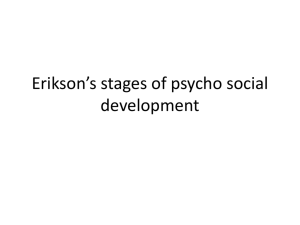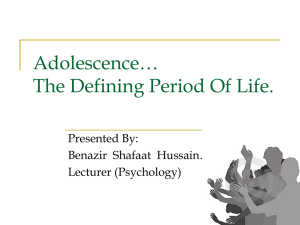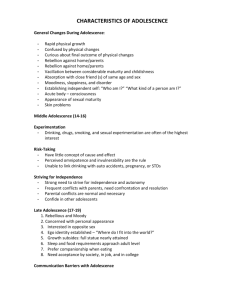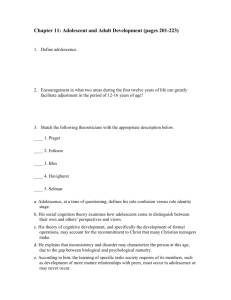Adolescence (Twelve to Eighteen Years)
advertisement
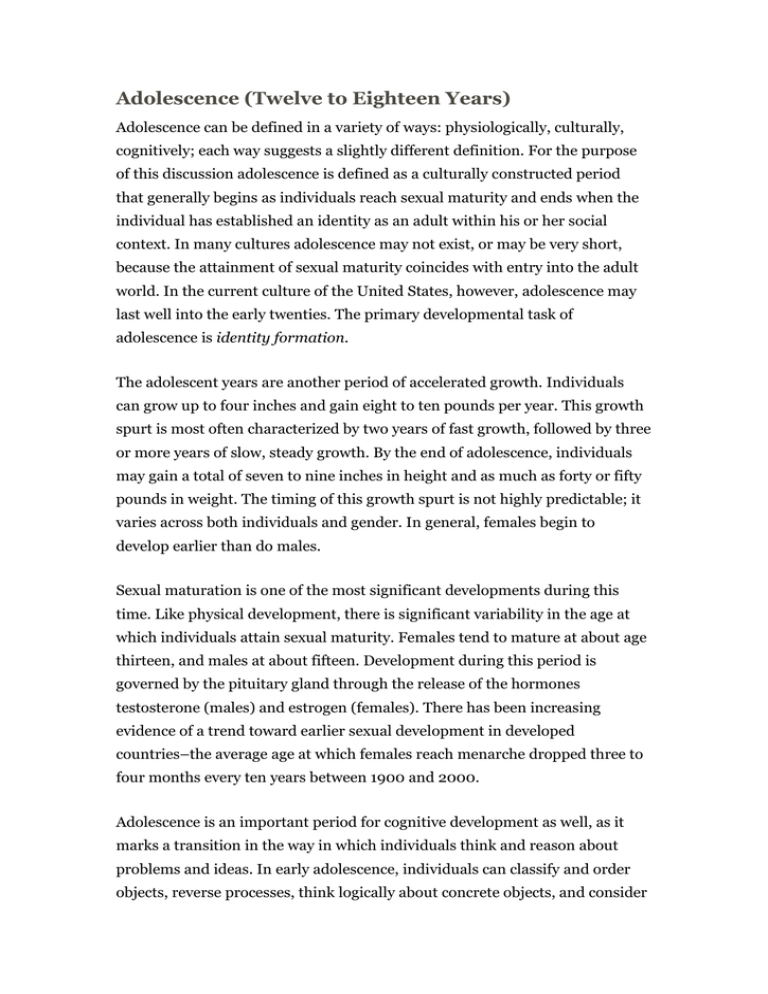
Adolescence (Twelve to Eighteen Years) Adolescence can be defined in a variety of ways: physiologically, culturally, cognitively; each way suggests a slightly different definition. For the purpose of this discussion adolescence is defined as a culturally constructed period that generally begins as individuals reach sexual maturity and ends when the individual has established an identity as an adult within his or her social context. In many cultures adolescence may not exist, or may be very short, because the attainment of sexual maturity coincides with entry into the adult world. In the current culture of the United States, however, adolescence may last well into the early twenties. The primary developmental task of adolescence is identity formation. The adolescent years are another period of accelerated growth. Individuals can grow up to four inches and gain eight to ten pounds per year. This growth spurt is most often characterized by two years of fast growth, followed by three or more years of slow, steady growth. By the end of adolescence, individuals may gain a total of seven to nine inches in height and as much as forty or fifty pounds in weight. The timing of this growth spurt is not highly predictable; it varies across both individuals and gender. In general, females begin to develop earlier than do males. Sexual maturation is one of the most significant developments during this time. Like physical development, there is significant variability in the age at which individuals attain sexual maturity. Females tend to mature at about age thirteen, and males at about fifteen. Development during this period is governed by the pituitary gland through the release of the hormones testosterone (males) and estrogen (females). There has been increasing evidence of a trend toward earlier sexual development in developed countries–the average age at which females reach menarche dropped three to four months every ten years between 1900 and 2000. Adolescence is an important period for cognitive development as well, as it marks a transition in the way in which individuals think and reason about problems and ideas. In early adolescence, individuals can classify and order objects, reverse processes, think logically about concrete objects, and consider more than one perspective at a time. However, at this level of development, adolescents benefit more from direct experiences than from abstract ideas and principles. As adolescents develop more complex cognitive skills, they gain the ability to solve more abstract and hypothetical problems. Elements of this type of thinking may include an increased ability to think in hypothetical ways about abstract ideas, the ability to generate and test hypotheses systematically, the ability to think and plan about the future, and metacognition (the ability to reflect on one's thoughts). As individuals enter adolescence, they are confronted by a diverse number of changes all at one time. Not only are they undergoing significant physical and cognitive growth, but they are also encountering new situations, responsibilities, and people. Entry into middle school and high school thrusts students into environments with many new people, responsibilities, and expectations. While this transition can be frightening, it also represents an exciting step toward independence. Adolescents are trying on new roles, new ways of thinking and behaving, and they are exploring different ideas and values. Erikson addresses the search for identity and independence in his framework of life-span development. Adolescence is characterized by a conflict between identity and role confusion. During this period, individuals evolve their own self-concepts within the peer context. In their attempts to become more independent adolescents often rely on their peer group for direction regarding what is normal and accepted. They begin to pull away from reliance on their family as a source of identity and may encounter conflicts between their family and their growing peer-group affiliation. With so many intense experiences, adolescence is also an important time in emotional development. Mood swings are a characteristic of adolescence. While often attributed to hormones, mood swings can also be understood as a logical reaction to the social, physical, and cognitive changes facing adolescents, and there is often a struggle with issues of self-esteem. As individuals search for identity, they confront the challenge of matching who they want to become with what is socially desirable. In this context, adolescents often exhibit bizarre and/or contradictory behaviors. The search for identity, the concern adolescents have about whether they are normal, and variable moods and low self-esteem all work together to produce wildly fluctuating behavior. The impact of the media and societal expectations on adolescent development has been farreaching. Young people are bombarded by images of violence, sex, and unattainable standards of beauty. This exposure, combined with the social, emotional, and physical changes facing adolescents, has contributed to an increase in school violence, teen sexuality, and eating disorders. The onset of many psychological disorders, such as depression, other mood disorders, and schizophrenia, is also common at this time of life. Implications for in-school learning. The implications of development during this period for education are numerous. Teachers must be aware of the shifts in cognitive development that are occurring and provide appropriate learning opportunities to support individual students and facilitate growth. Teachers must also be aware of the challenges facing their students in order to identify and help to correct problems if they arise. Teachers often play an important role in identifying behaviors that could become problematic, and they can be mentors to students in need.




